In 1995, technically gifted attacker Pablo Correa joined AS Nancy Lorraine from Montevideo Wanderers in his native Uruguay.
In his first season with Les Chardons, he helped them earn promotion to Ligue 1.
From there, he’d go on to strike up a memorable offensive partnership in the club’s history alongside Republic of Ireland international Tony Cascarino.
Shortly after retiring as a player, Correa joined Nancy’s coaching staff in the year 2000.
Two years later, he’d go on to become the club’s manager, replacing Moussa Bezaz.
The Uruguayan would go on to hold that position as Nancy boss for just short of a decade, leaving at the end of the 2010/11 season with the club having earned promotion to Ligue 1.
After that, they enjoyed a period of stability in the French top flight for the remainder of Correa’s initial tenure and won the 2006 Coupe de la Ligue title, thus qualifying for European football.
Correa returned in 2013/14 with Nancy back down in Ligue 2.
Once again, he engineered progress for the Grand Est club and masterminded yet another promotion to the top flight in 2015/16, though it would be short-lived as they went back down the following season.
A poor start to the subsequent 2017/18 season in the second tier marked the end of Correa’s second stint as Nancy boss.
However, the now-57-year-old veteran of Stade Marcel-Picot returned in 2023, with Les Chardons now playing their football in France’s third-tier, Championnat National, with the single goal of propelling them up the French football ladder once more.
Last season, after returning to the club in November, Correa guided Nancy to a sixth-place finish.
Now, six games into the 2024/25 campaign, Nancy sit second in the division and look like a team that means business to mount a promotion push this term.
Our tactical analysis piece aims to provide insight into how Correa is setting up his team to challenge for promotion to Ligue 2 this season.
Our analysis focuses on how Correa’s tactics are centred on maximising his side’s capacity to threaten in transitions.
Pablo Correa Counterpressing Tactics
Firstly, counterpressing is a notable element of this Nancy side’s tactics.
So far this season, they’ve completed 95 counterpressing recoveries in National 1, equalling 15.83 counterpressing recoveries per 90.
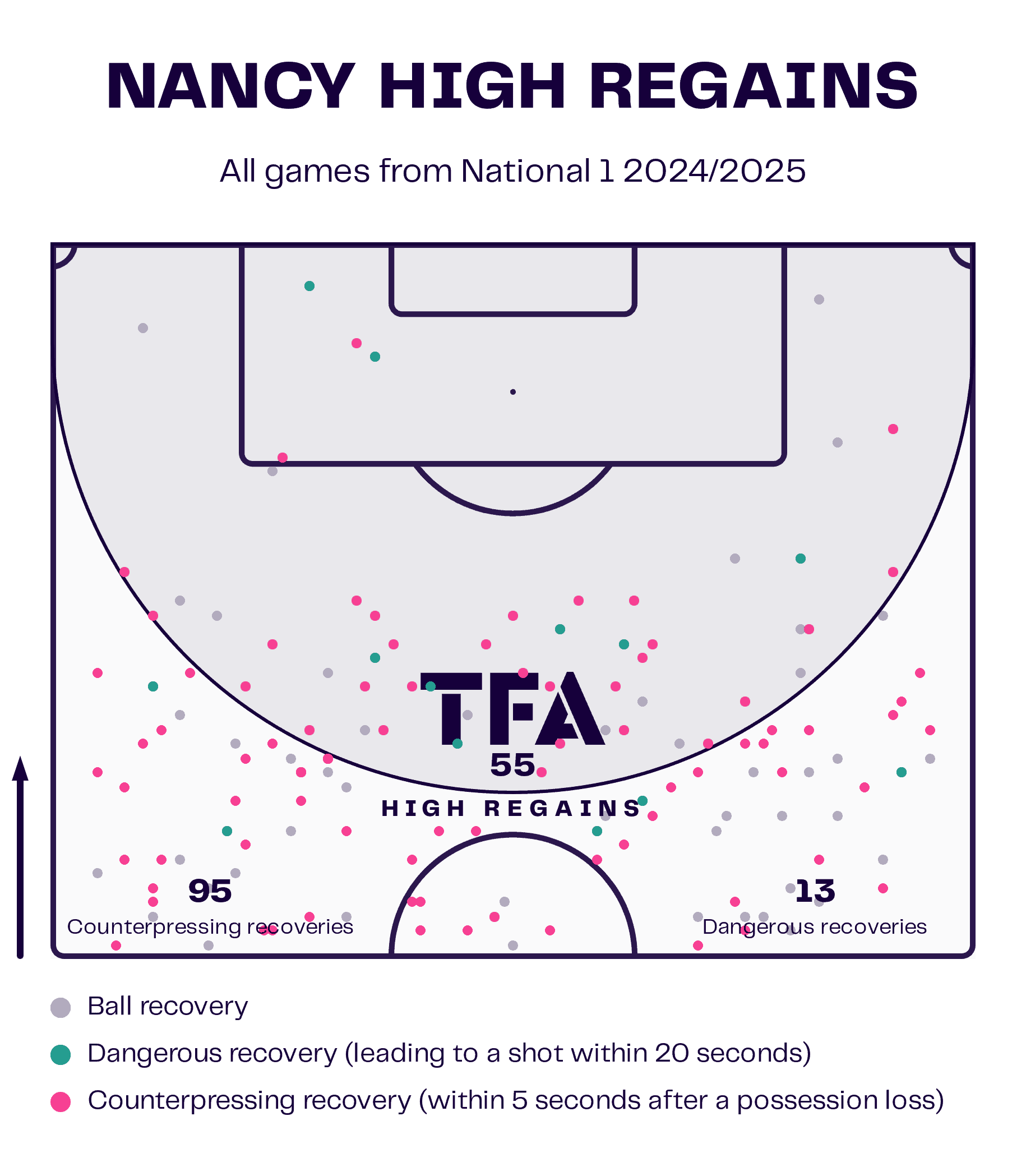
These 95 counterpressing recoveries were accompanied by 55 high regains (the shaded area on our viz) and 13 dangerous recoveries (defined on the viz).
Their 13 dangerous recoveries (just over two per match) display the effectiveness of their transitional attacks, which have been a staple of their tactics this term.
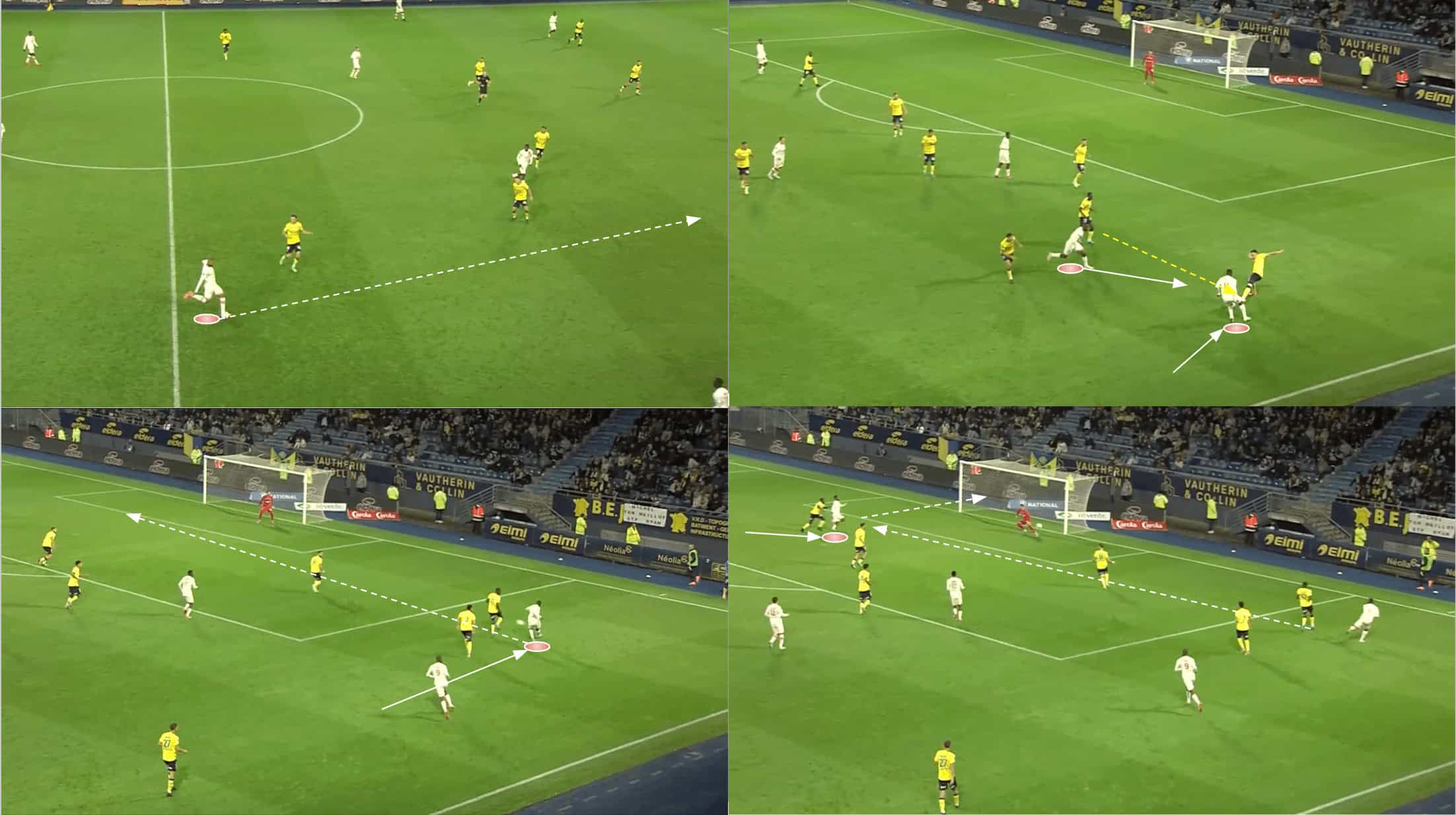
More of Nancy’s ball progression has come down the right-hand side of the pitch than the left this season — especially via the right-back (Adrien Julloux) and right-holding midfielder (Maxence Carlier).
We see them progressing into the final third via their right centre-back, Nicolas Saint-Ruf, in figure 2.
Immediately after getting the ball into the final third, Nancy lose it.
Still, they can get right on top of the opposition, Sochaux, and apply pressure to them inside the final third, as shown in the image above at the top right.
After recovering from their high pressure, Nancy creates a goalscoring opportunity with a cross from the right wing, which meets the left-winger’s darting run on the defender’s blindside towards the back post, from where he can convert into an inviting Sochaux net.
This passage of play highlights the aggressive counterpressing nature and readiness to counterpress of this Nancy side.
They’re happy to take some risks on the ball and get it forward into the final third early, knowing that if they do lose it, they have the necessary tools to win it back and keep moving forward, as figure 2 demonstrates.
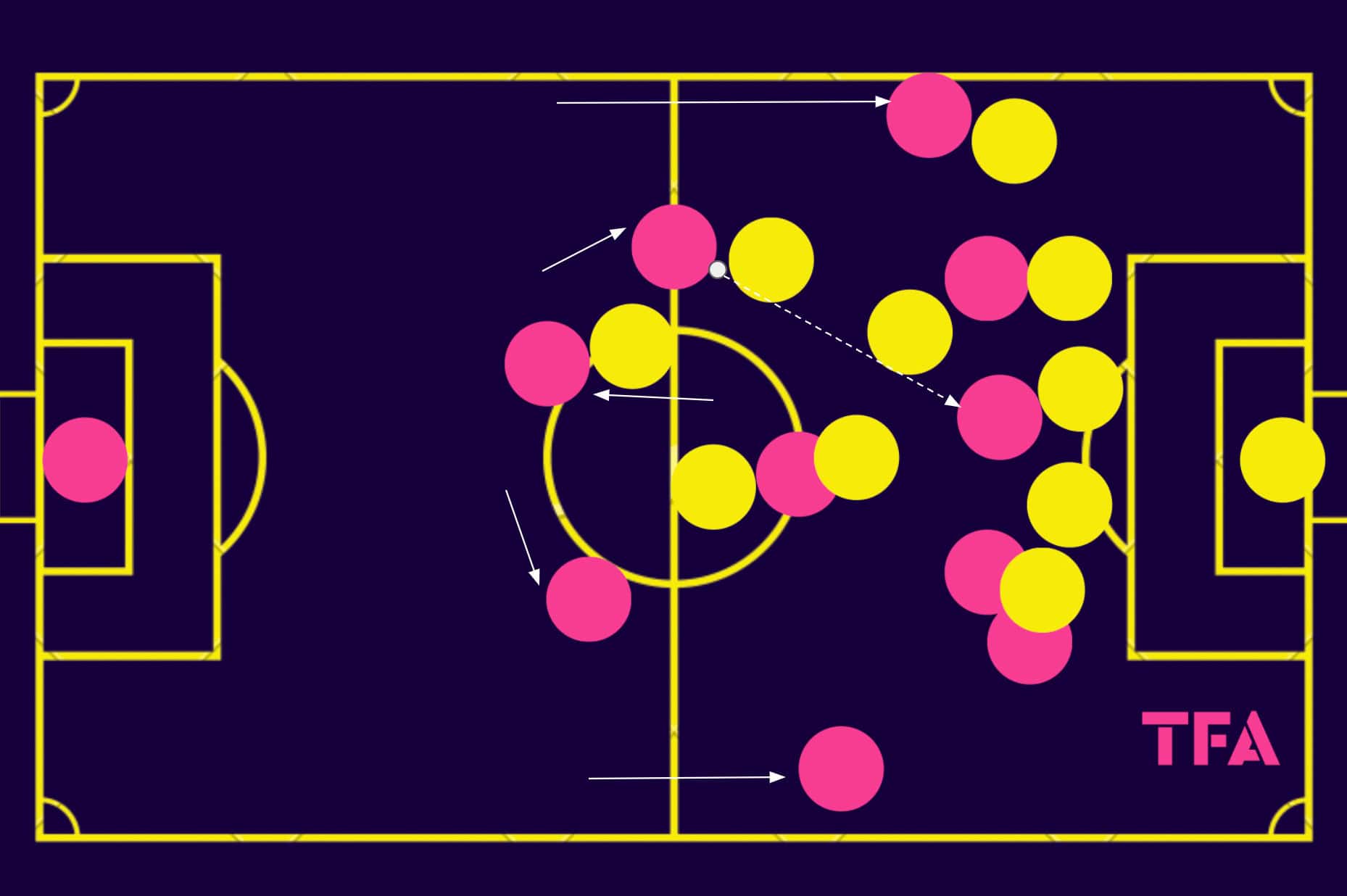
In this game against Sochaux, Nancy deployed a 4-3-3 shape.
For most of the season, they’ve been utilising a 4-2-3-1 shape.
However, regardless of shape, it’s normal to find one of their midfielders dropping into the backline during the build-up/ball progression phases, as was the case in figure 3, with Nancy (pink) trying to progress against Sochaux (yellow).
The holding midfielder dropped in between Nancy’s centre-backs, giving them a +1 numerical advantage over Sochaux’s two-man forward line.
At this point, one midfielder moved forward to play as more of a ‘10’ while the other remained central, forming the tip of a diamond-style shape at the base of Nancy’s structure.
Les Chardons’ centre-backs moved wider as their full-backs positioned themselves higher on the wings to give the centre-backs passing options and try to stretch the opposition’s backline or make use of the space out wide in the opposition’s half if they remained very horizontally compact and constrained to central areas.
This creates a 3-1-6 base structure, which gives Nancy something to build from and a safety net to counterpress should they turn the ball over.
However, opponents can still exploit Nancy in transition if they regain possession and make it past the forward line.
Their full-backs will try to recover quickly, but there is a period of time when Nancy’s defence is significantly weakened, and the lone midfielder left in the middle of the park can be quite easily overloaded, which lends itself to Les Chardons being hurt on the break.
Immediate pressure on the ball-carrier should a turnover occur, and willingness to track back is necessary for Nancy’s transition defence to have a chance of success.
Pablo Correa Counterattacking Tactics
Correa’s Nancy have been set up to thrive in transition this term.
One element of that has been their solid counterpressing approach; another has been their ability to create via counterattacks.
This section will highlight a few examples of Nancy creating on the counter, illustrating their defensive tactics to recover the ball and then their transitional competence to make the most of the subsequent opportunity which presents itself.
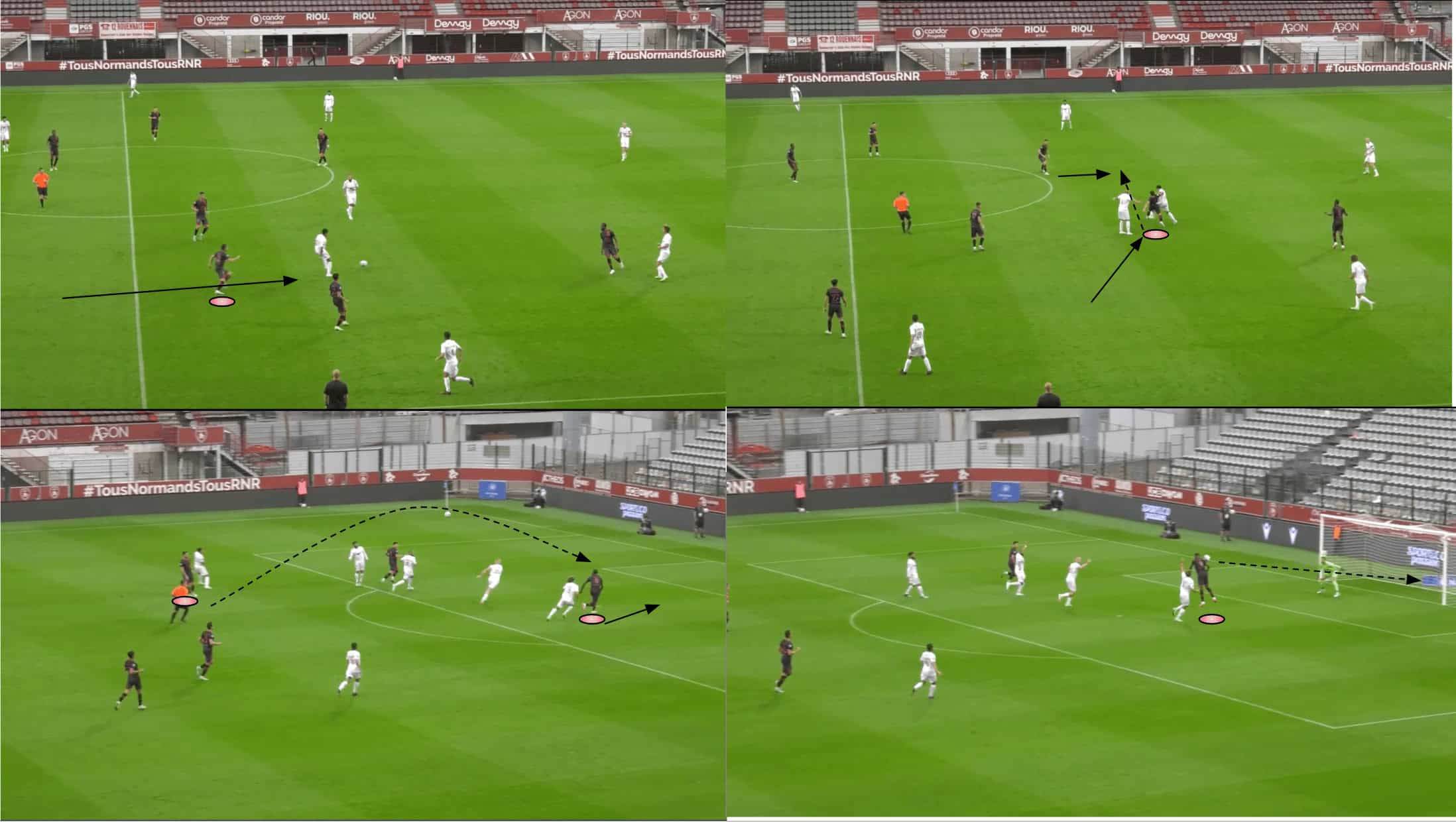
This passage of play provides an example of Nancy’s right-back, Adrien Julloux, getting drawn high to press the opposition’s winger, who has dropped deep out of the right-back’s zone but still draws his attention to prevent that player from becoming a free man and overloading the midfielders, who are preoccupied with other potential threats.
It’s common to find Nancy’s full-backs and holding midfielders getting drawn higher than you might expect like this to follow a player who is dropping well out of their regular position to prevent them from enjoying too much space.
Here, as this winger receives and carries the ball centrally, he’s followed and ultimately dispossessed by Julloux, who can poke the ball to a midfield teammate.
This player carries the ball forward and quickly spots forward Cheikh Ibrahima Touré, getting into a good goalscoring position.
The ball carrier spotted Touré and picked him out with a well-executed ball, allowing the attacker to enjoy a great headed opportunity.
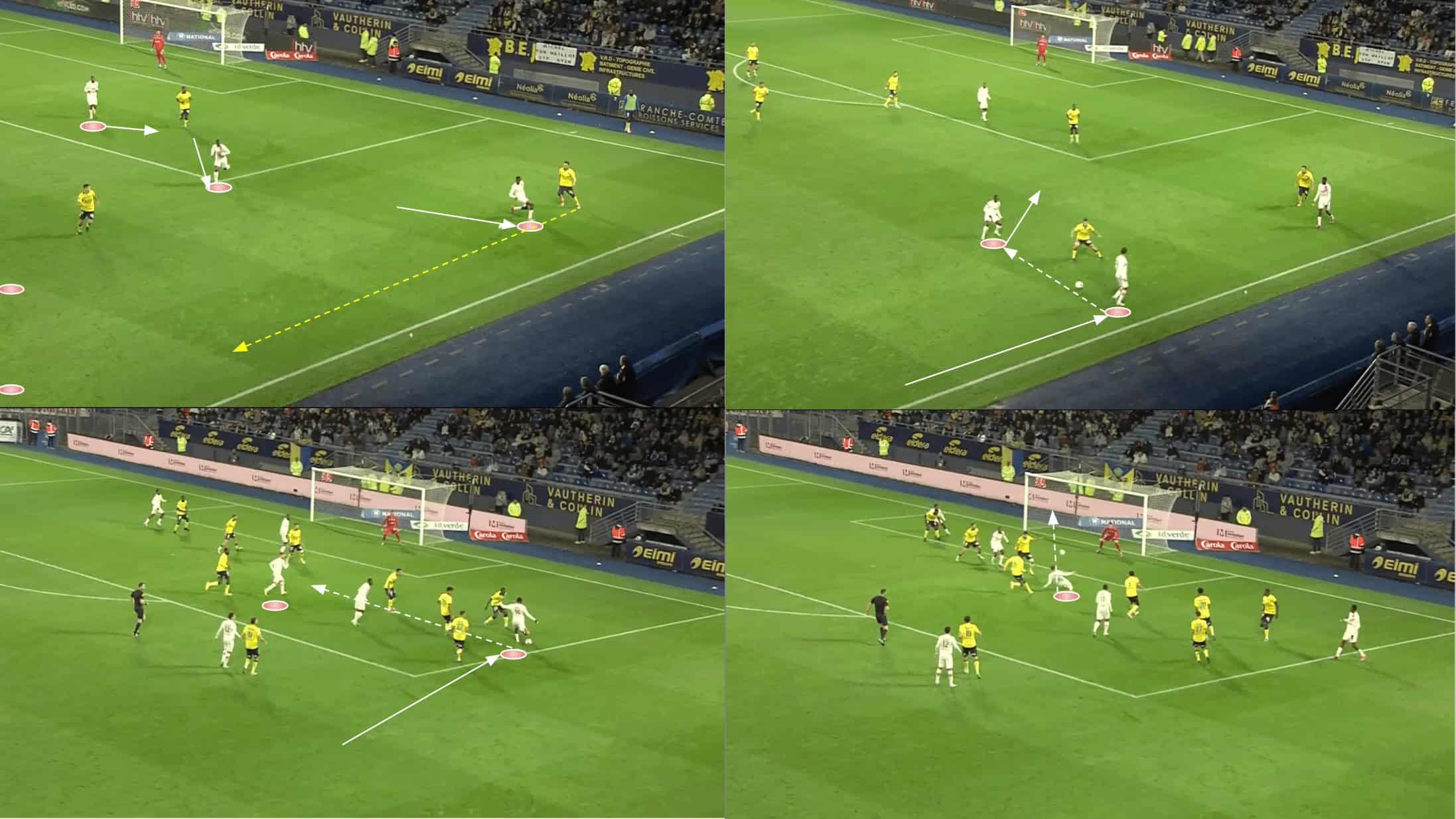
In Figure 5, versus Sochaux again, we find Nancy pressing their opponents aggressively on the right wing.
Both wingers and the centre-forward move to the right of the pitch to try and constrict the opponent’s space to play out of danger.
As Sochaux send the ball up the wing, Nancy’s right-back is there to close down the intended receiver and dispossess him before linking up with the right-winger just alongside, who has also shifted over in support of the team’s effort to pin the opponent into a confined space at the full-back position.
The winger receives and carries forward excellently, showcasing his dribbling ability and how important this is for Nancy’s wingers as part of their transitional tactics this term, into a good playmaking position on the edge of the box from where he can set up a goalscoring opportunity.
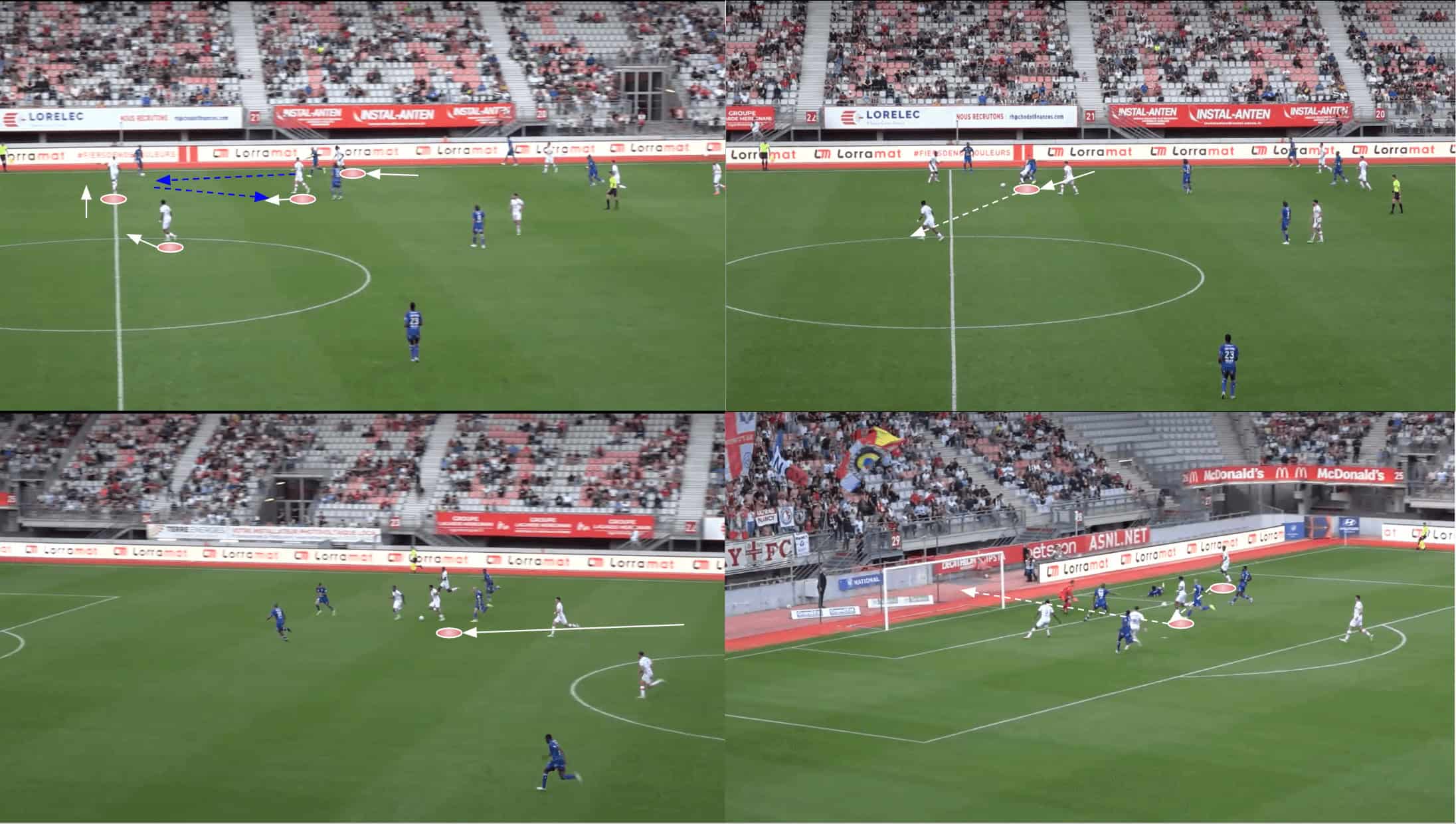
As we saw above, Nancy’s forward line shifted to the right wing to congregate around the opponent’s right back.
They did the same in Figure 6, this time with the camera angle better positioned to capture how this looks in their 4-2-3-1 setup.
With the opposition’s right-back having just received the ball, Nancy’s striker comes over to cut off his passing lane to the right centre-back while the right-winger advances onto the passing option further up the wing.
Nancy’s ‘10’ also comes over to cut off the passing lane into midfield.
At the same time, the left-winger is not far, potentially cutting off access to a switch across the field while also retaining access to the ball-near centre-back should the full-back on the ball get past the striker covering that option.
The opponent tries to play it down the wing, and the right-winger is there to pull off the interception.
This sets Nancy up for a good counterattacking opportunity, which leads to a goal, as the bottom two images depict.
This wide pressing trap with Nancy’s closely positioned forwards has been a notable element of the team’s tactics this term.
As seen in figures 5 and 6, it has consistently generated high turnovers and good counterattacking opportunities.
Pablo Correa Crossing Tactics
Our third and final section of this analysis will put a bit of a spotlight on something else we’ve seen consistently pop up throughout this analysis — Nancy’s crossing and its significance in their attacking play this term.
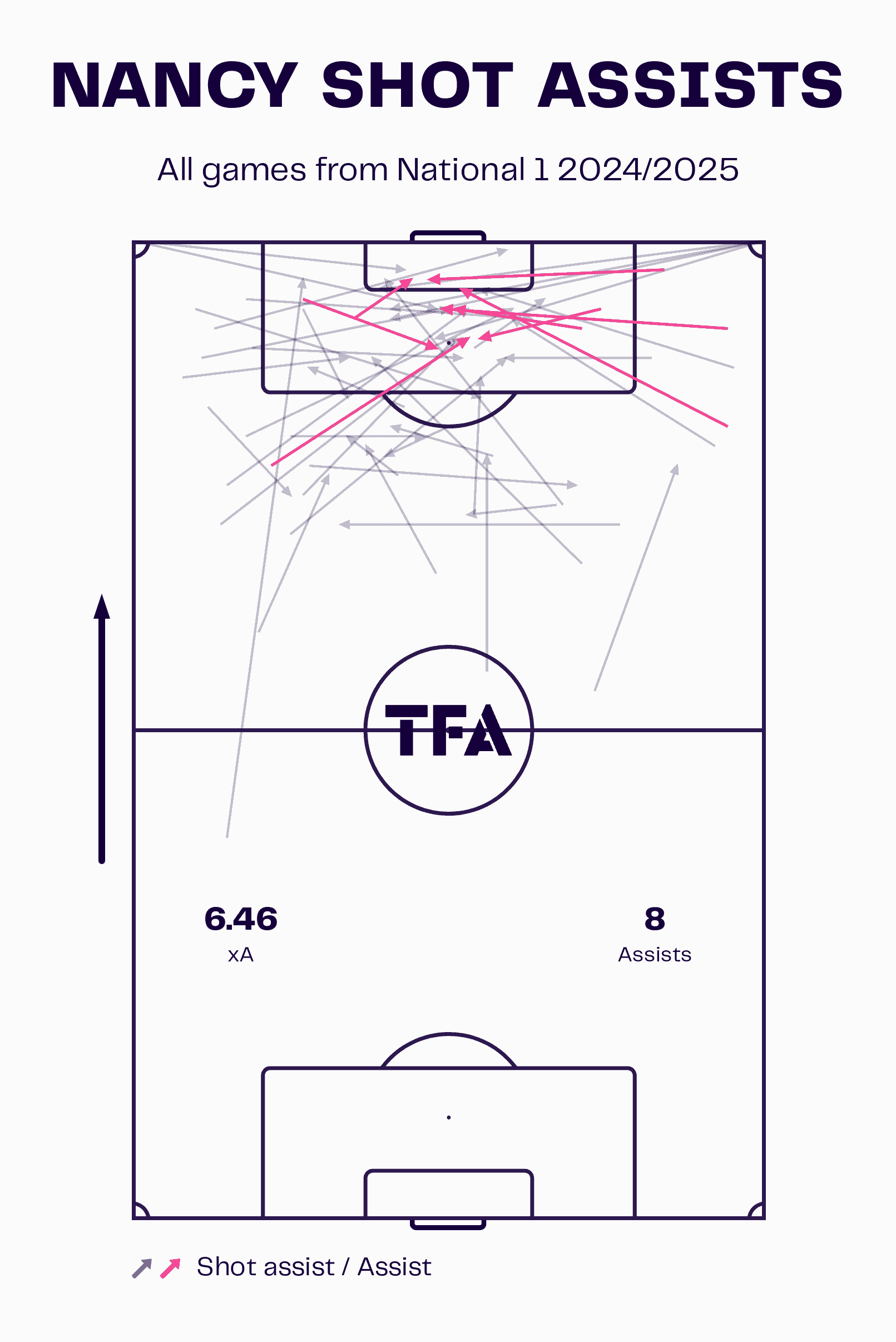
Looking at Nancy’s shot assist map for the current campaign above, we can see how so many of their chances have been created from either the wing or the half-space — key crossing locations.
Nancy’s wingers are key dribblers for the team and Les Chardons’ heaviest crossers—a direct result of their heavy involvement in the team’s pressing and counterpressing and their dribbling ability to frequently progress into good crossing positions.
However, Nancy’s full-backs also play a notable role in the team’s crossing game, as figure 8 shows.
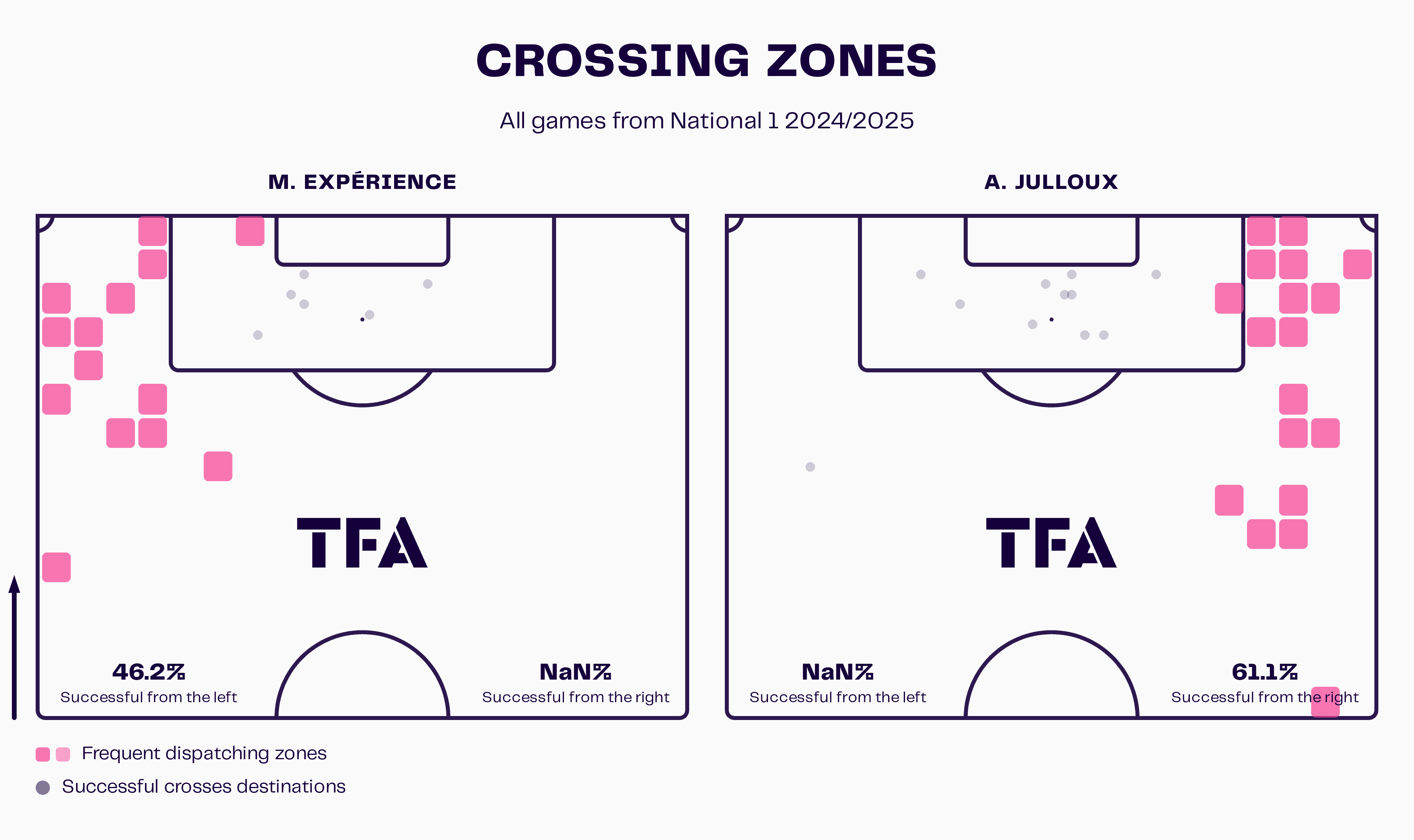
With Nancy attacking more heavily down the right, Julloux has been slightly more involved than Expérience this term.
Furthermore, with a 61.1% cross success rate, Julloux has been more reliable than Expérience with his crossing as well.

Firstly, above, we see Expérience overlapping from deep to support the right-winger on the ball who’s carrying inside, also creating space for the right-back to overlap.
The winger plays the ball inside to the central midfielder, generating a little bit more space for the full-back before playing it out to Expérience.
Now, with time and space to get his head up, Expérience can pick out a teammate inside the box and play a good cross into the area, setting up a great goalscoring opportunity from the six-yard box.
Conclusion
In conclusion, Nancy have done very well to generate a lot of chances from high-percentage shot locations this term.
Their tactics in transition — both defensive and offensive — along with their ability to generate space on the wings via wide overloads to create decent crossing opportunities, have been vital to this effective attacking trend in their campaign.
Correa will be hoping they can maintain their current level over the course of the season to potentially put a third Nancy promotion on his CV — he’s certainly done well to get them looking like early contenders based on what we’ve seen so far in 2024/25.

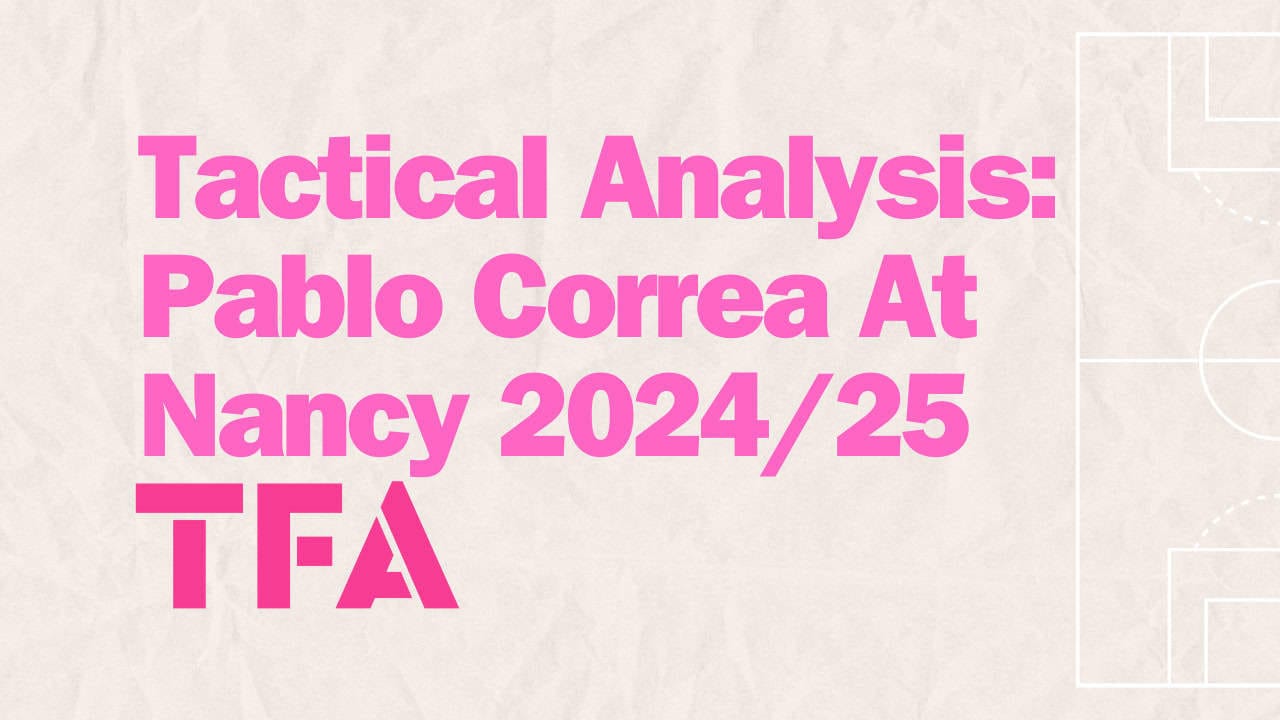



Comments